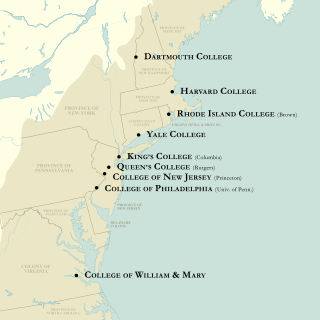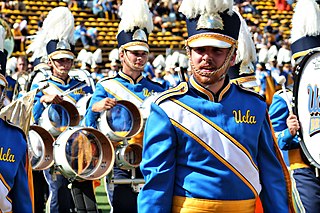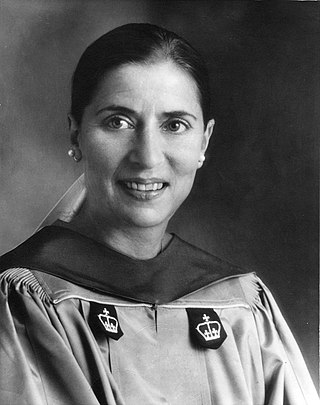
The Ivy League is an American collegiate athletic conference, comprising eight private research universities in the Northeastern United States. The conference headquarters are in Princeton, New Jersey. The term Ivy League is typically used outside sports to refer to the eight schools as a group of elite colleges with connotations of academic excellence, selectivity in admissions, and social elitism. Its members are Brown University, Columbia University, Cornell University, Dartmouth College, Harvard University, Princeton University, University of Pennsylvania, and Yale University.

The University of Pennsylvania is a private Ivy League research university in Philadelphia, Pennsylvania. It is one of nine colonial colleges chartered prior to the U.S. Declaration of Independence when Benjamin Franklin, the university's founder and first president, advocated for an educational institution that trained leaders in academia, commerce, and public service. Penn identifies as the fourth oldest institution of higher education in the United States, though this representation is challenged by other universities, as Franklin first convened the Board of Trustees in 1749, arguably making it the fifth oldest institution of higher education in the U.S.

Academic dress is a traditional form of clothing for academic settings, mainly tertiary education, worn mainly by those who have obtained a university degree, or hold a status that entitles them to assume them. It is also known as academical dress, academicals, and, in the United States, as academic regalia.

The colonial colleges are nine institutions of higher education chartered in the Thirteen Colonies before the United States of America became a sovereign nation after the American Revolution. These nine have long been considered together, notably since the survey of their origins in the 1907 The Cambridge History of English and American Literature.

School colors are the colors chosen by a school as part of its brand identity, used on building signage, web pages, branded apparel, and the uniforms of sports teams. They can promote connection to the school – or 'school spirit' – and help differentiate it from other institutions.

Regalia is the set of emblems, symbols, or paraphernalia indicative of royal status, as well as rights, prerogatives and privileges enjoyed by a sovereign, regardless of title. The word originally referred to the elaborate formal dress and accessories of a sovereign, but now it also refers to any type of elaborate formal dress. The word stems from the Latin substantivation of the adjective regalis, "regal", itself from rex, "king". It is sometimes used in the singular, regale.

First university in the United States is a status asserted by more than one U.S. university. When the Philippines was still a United States territory, the University of Santo Tomas, which was established in 1611, was considered the oldest university under the American flag. Presently in the United States, there is no official nationwide definition of what entitles an institution to be considered a university versus a college while differing official definitions are used at the state level, and the common understanding of university has evolved over time. The 1911 Encyclopædia Britannica describes the gradual emergence of U.S. universities as follows:
In the United States the word university has been applied to institutions of the most diverse character, and it is only since 1880 or thereabouts that an effort has been seriously made to distinguish between collegiate and university instruction; nor has that effort yet completely succeeded. Harvard, William and Mary, and Yale. .. were organized. .. on the plans of the English colleges which constitute the universities of Oxford and Cambridge. Graduates of Harvard and Yale carried these British traditions to other places, and similar colleges grew up in New York, New Jersey, Pennsylvania, New Hampshire and Rhode Island.... Around or near these nuclei, during the course of the 19th century, one or more professional schools were frequently attached, and so the word university was naturally applied to a group of schools associated more or less closely with a central school or college. Harvard, for example, most comprehensive of all, has seventeen distinct departments, and Yale has almost as many. Columbia and Penn have a similar scope. In the latter part of the 19th century Yale, Columbia, Princeton and Brown, in recognition of their enlargement, formally changed their titles from colleges to universities.

The academic dress of the University of Melbourne refers to the formal attire, including robes, gowns, and hoods, as prescribed by the Statutes and Regulations for undergraduates, graduates, officers, and honorands of the university. This follows the style of the University of Oxford for the gowns and hoods for Bachelors and Masters degrees. Melbourne adopts the style of the University of Cambridge for its doctorates. The hoods are all black, resembling the size and shape of the Oxford MA hoods, which are in the simple Burgon shape. These hoods are lined with the color specified for the corresponding faculty or degree and are bound with white on the lower edge for bachelors, while masters' hoods have no binding. The specific faculty or degree colors are outlined in the University Regulations. In the past, Pass degrees were bound in fur and Honours degrees in silk; however, this distinction no longer holds. Bachelors wear an Oxford Bachelors gown, while Masters wear an Oxford Masters gown. The gown for undergraduate students is the same as the bachelors', but its sleeves must not be split.
University of Pennsylvania student life includes numerous events and social gatherings around campus, with some sponsored by the college.

As the oldest college in the United States, Harvard University has a long tradition of academic dress. Harvard gown facings bear crow's-feet emblems near the yoke, a symbol unique to Harvard, made from flat braid in colours distinctive of the wearer's qualification or degree. Crow's-feet are double for earned degrees, and triple for honorary degrees.

Columbia University has developed many traditions over its 269-year-long existence, most of them associated with its oldest undergraduate division, Columbia College.

The Penn Quakers are the athletic teams of the University of Pennsylvania. The school sponsors 33 varsity sports. The school has won three NCAA national championships in men's fencing and one in women's fencing.

Academic dress has a history in the United States going back to the colonial colleges era. It has been most influenced by the academic dress traditions of Europe. There is an Inter-Collegiate Code that sets out a detailed uniform scheme of academic regalia that is voluntarily followed by many, though not all institutions entirely adhere to it.

The academic regalia of Stanford University describes the robes, gowns, and hoods which are prescribed by the university for its graduates. Stanford University was founded in 1891 and academic dress has been a part of academic life at the school since at least 1899. As in most American universities, the academic dress found at Stanford is derived from that of the universities of Oxford and Cambridge, which was a development of academic and clerical dress common throughout the medieval universities of Europe. Today, also in common with most American universities, academic regalia is commonly seen only at graduation ceremonies. For most of its academic dress, Stanford follows the Intercollegiate Code of Academic Costume which was devised in 1895 and sets out a detailed uniform scheme of academic regalia. Stanford does make use of a distinct robe for its PhD graduates which is unique among American institutions of higher education in being based specifically on the doctoral robes of the University of Cambridge.
The procedures and traditions surrounding academic graduation ceremonies differ around the world.

The khrui is a light outer garment worn as a gown or robe in certain ceremonial settings in Thailand. It is long-sleeved and open at the front, and is made of a sheer or mesh fabric, lined with a band of satin, felt or other material, and may be exquisitely embroidered. Dating from at least the 17th century, it was originally worn only in the royal court, but nowadays is most recognisable as the form of academic dress employed by many universities, especially Chulalongkorn University.

The academic dress of McGill University describes the caps, gowns and hoods which are prescribed by the university for its degree candidates/holders. Until the mid-20th century, McGill also prescribed academic dress for its matriculating or enrolled students as well as its faculty. Founded in 1821, McGill University is consistently ranked as one of Canada's preeminent universities, and among the top 20 universities in the world.

What was originally called Harvard College (around which Harvard University eventually grew) held its first Commencement in September 1642, when nine degrees were conferred. Today some 1700 undergraduate degrees, and 5000 advanced degrees from the university's various graduate and professional schools, are conferred each Commencement Day.

The academic regalia of Columbia University are the robes, gowns, and hoods which are prescribed by the university for its graduates. As one of the oldest universities in the United States, Columbia University has a long tradition of academic dress dating back to its founding in the 18th century, when it became the second university in the country to formally adopt academic robes. The development of Columbia's academic regalia has strongly influenced those of most universities in the United States. Since the passing of the Intercollegiate Code of Academic Costume in 1895, the style of academic dress worn at the university in the late 20th century has served as the basis of those of most other universities in the country. Though once worn daily by students at the university, caps and gowns now are only worn during commencement.

The first commencement at Columbia University was held on June 21, 1758, when the university, then known as King's College, conferred seven degrees upon its first graduating class. Today, the university graduates several thousand students each year from its several undergraduate colleges, graduate schools, and affiliated institutions. University Commencement traditionally takes place on the third Wednesday of May.



















